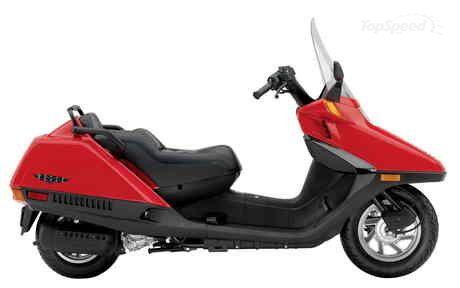|
|
Post by scooter on Feb 11, 2015 17:40:38 GMT -5
All done. Finished up the handlebars last night. The whole bike is painted. No more a RU PAUL scoot. It's not perfect, but I really don't care. Anything is better than the pink and purple feathers and a stupid green beak. Here are the last pics of the completed job. Not bad for a complete amateur if I do say so myself.   The scoot looks nice. I'd hate to see you ruin it with some strategically placed pinstripe work.  |
|
|
|
Post by scooter on Feb 9, 2015 20:29:17 GMT -5
That's a really neat scooter. How big are the back tires? |
|
|
|
Post by scooter on Feb 9, 2015 18:03:13 GMT -5
Here's another video for discussion about defensive riding and also about awareness. Check this mess out. I think this is what war must look like. Bodies strewn around, chaos, destruction. |
|
|
|
Post by scooter on Feb 9, 2015 17:46:55 GMT -5
Check this one out guys,,87 MPH..hold on!!!!!!! Prolly one of those $2500 blocks...sounds like he keeps the same RPM from the hole all the way to the finish line..lol Nice! What is that grating sound it's making? |
|
|
|
Post by scooter on Feb 9, 2015 17:35:09 GMT -5
Some systems work on magnetism, some based on weight, new systems work on motion detection. Some older systems also have a strobe light detector that can be activated by flashing your high-beams, but I think those are pretty rare now days due to public abuse. Some people have strapped magnets to the bottom of their scooters and reported success. I have heavy doubts that magnets will work, even if an induction loop can be effected by a magnet, i doubt you'd find one strong enough. An electromagnet might work, and it would definitely effect the older magnetism systems, but those and weight ones i think are mostly gone. Actually at the light where its the biggest issue, even triggering the light would only help so much as the lights are purely sensor activated, and very hyperactive. I used to work in that area which is mostly industrial, and semis typically wound up running the lights because they switched so quickly. javarod, ramblinman, JerryScript, JoeyBee, scootdude, dmartin95, scooter For the red lights, try this. It's practically free and the worse thing that will happen is it won't work: To recap: Take a 12" piece of wire, form it into a circle, tie the metal ends together so it makes one conductor. Place as low to the ground on the scooter as possible, in the same orientation it would be if it were lying on the ground. Tape it on, tie wrap it on, whatever. Then try it out and tell us if it works.  I don't know if it needs to be solid or braided. I get the impression it may not matter. Interesting, i'm figuring some study is in order. Yes. I tried the loop, under the bike, on a stoplight that never gives me the left turn signal, this morning and it didn't trip that sensor. My bike alone has been tripping regular lights though. Next I want to lower the loop away from the bike to avoid interference from the frame, and see if that works. If that doesn't work, I'm going to try another mod on it and see what happens. What would be nice is to put the loop on a stick and try it out at a light, by hand, and see if it works, and if and how you have to move the loop to get it to work. From the article I was reading, it looks like you might have to move the loop either side to side, across the sensor, or parallel along the sensor. I'd like to keep working on this approach before getting into any electronics. |
|
|
|
Post by scooter on Feb 9, 2015 17:27:48 GMT -5
Smirks and bows, "I suppose it really shouldn't be any surprise that i'd come up with that, i like puns, bad jokes, and love to have fun with company names. For two years i ran Tachyon Express 'Yesterday? We can do that' as a sub-contractor to a courier company (running an 02 Kia Sedona which i found out can handle 8+ inches of snow)." Hahaha! "When you need it yesterday." That's great. |
|
|
|
Post by scooter on Feb 9, 2015 17:25:13 GMT -5
There are so many variables in these scooters that I think anyone would be hard pressed to just call out a number unless they knew a whole lot about scooters and had actually tried dozens of configurations of rollers, springs, exhausts, intakes, etc. Yeah, I get that there's no crystal ball here.... I'm just confused because I'm getting conflicting info here and there.... This specific carb will be installed on a 180cc GY6.... It was listed for a 125/150 and the jet size is 40 pilot and 125 main... Is what's weird is that it came with two extra pilots... Not mains... Seeing as how it's listed for a 150cc, maybe they include those pilots because that's what needs to be tweaked... Or I could just be reading way too much into the accessories  ...... But why did they include those pilots? I think I'm over thinking this... I may just need to get a main and pilot jet set and tune away till I get it... I do have an O2 sensor.... It wasn't going on this build but I can use it just to calibrate the scooter then seal up the bung...  I don't know if they meant to give you two pilots. I got a variator kit once, and they gave me rollers.. which were not listed in the ad as part of the set. Freebies. I liked Alley's post on how to tune a pilot jet, and I agree, it's nice to have a variety of parts to tune with, jets, rollers, etc. I think I tried 5 or more roller variations on my last scoot, maybe 7, until I got what I wanted, and the spares are good because, if you change anything, you might need to change something else to match. Good luck on your build. I want one of those O2 sensors for tuning, myself. Some day....  |
|
|
|
Post by scooter on Feb 8, 2015 16:55:29 GMT -5
To recap: Take a 12" piece of wire, form it into a circle, tie the metal ends together so it makes one conductor. Place as low to the ground on the scooter as possible, in the same orientation it would be if it were lying on the ground. Tape it on, tie wrap it on, whatever. Then try it out and tell us if it works. No way! Are you serious? All these years I thought for sure there were weight sensors at the intersections. At most intersections you can even see the "cut out" section where the sensors lie beneath. Who knew it was as simple as a wire loop? LOL! I'm going to try it out! Thanks for the info! You're welcome. It also says that bikes should drive right onto one of the strips, as opposed to being between them. |
|
|
|
Post by scooter on Feb 8, 2015 16:41:41 GMT -5
I'm with Paladin here. These two idiots just sit in their car laughing like hyenas. Then the Ape leaves and they continue to just sit there. I suppose they were hoping to see him come back around again? And golly, their patience was rewarded. One, get a life. Two, get some niceness and go out and help. At least the Ape driver had a sense of humor, plus probably knew full well he had that poor thing WAY overloaded! >'Kat He really blew it when he let the one guy out. He was already doing wheelies with both of them in the front seat. |
|
|
|
Post by scooter on Feb 8, 2015 15:56:44 GMT -5
javarod, ramblinman, JerryScript, JoeyBee, scootdude, dmartin95, scooter For the red lights, try this. It's practically free and the worse thing that will happen is it won't work: "Loop sensitivity to a conductive object can be tested with a 12 inches (30 cm) long wire formed into a circle whose diameter is approximately 4 inches (10 cm). The circular loop forms an open electrical circuit when the wire ends are held such that they do not touch one another. No actuation should occur when the open circular loop is rapidly moved horizontally over the in-roadway inductive loop. When the ends of the circular loop are made to touch, forming a closed circuit before being thrust over the in-roadway loop, an actuation will occur because of the flow of eddy currents. This demonstrates that it is the shorted turn, and not the wire or vehicle mass, which is important in producing the actuation." www.fhwa.dot.gov/publications/research/operations/its/06108/02.cfmTo recap: Take a 12" piece of wire, form it into a circle, tie the metal ends together so it makes one conductor. Place as low to the ground on the scooter as possible, in the same orientation it would be if it were lying on the ground. Tape it on, tie wrap it on, whatever. Then try it out and tell us if it works.  I don't know if it needs to be solid or braided. I get the impression it may not matter.
|
|
|
|
Post by scooter on Feb 8, 2015 15:11:39 GMT -5
It'll be the Arch Scooter Company, we're in St Louis after all. We'll only offer one model, model NME, you only need one after all. The Arch NME. Nice:) |
|
|
|
Post by scooter on Feb 8, 2015 5:11:38 GMT -5
That little Piggy should have stayed home! |
|
|
|
Post by scooter on Feb 7, 2015 19:15:09 GMT -5
You'll want to put a shim in with your "boss", to widen the variator a little. I may do the same. I have to see if my shims fit this new bike. All I have is .25 millimeter shims though, which is about .010". The shims for sale online come in sizes down to .004" for very fine tuning. My new variator is so hard on the engine that it shudders on takeoff. The old worn out one worked better. I got the same top end speed but with much smoother take off. Got the same results on two bikes with that same variator. It could be the manufacturer's angle was off by a fraction of a degree on the new one. What variator do u have ? Update on shims. I finally got to try some shims out today. I put 1/2mm of shims (2 shims) in between the boss and the drive face and the low end shuddering went way down. I added two more shims and the shuddering has almost stopped. It has little to no shudder on take off. It's very faint, not at all like it was. On the top end I lost 5 mph, down to 65. I expected this because I was already able to wind out the motor without the shims, so I was not trying to overcome a low rpm issue like RCQ is. In his case, he may gain top end as well as acceleration. I am pretty sure that my variator is too tight at the bottom, and possibly slightly out of square, and that it needs to be shaved from zero at the top, down to .020" or so at the bottom, on both sides, or .040 on one side, depending on which sheave or both is off angle. That will make the shuddering go away, keep my good low end acceleration, and keep my 70mph top end speed. For now the setup is fine. I am going to ride it, get an indicator and test it and the drive shaft, then I may take it to a machine shop, but I really don't know any local machinists so I'm concerned they might mess it up. Not every machinist knows how to do delicate and exacting work. They could end up ruining it if they don't get how sensitive these units are to being the correct size and angle. The sad part is that the old worn variator works great and this new one stinks. I may just use the old one if I can't get this one machined cheaply. It may be time for me to start looking for a lathe for my shop. One of those combo lathe/mill machines might be nice. Not as nice as a big shop lathe and mill, but maybe good enough for scooter parts. I hope RCQ will try the shims. He has nothing to lose by doing it and I'd like to hear the results. I think if he can get his rpms up, he may be able to go faster. |
|
|
|
Post by scooter on Feb 7, 2015 11:01:08 GMT -5
I like the new look. The new front looks more modest. The old just hangs out a little too much. You should have created a poll like they have for the Monday things. I'll see if I can add one. Check out the new rear end as well. |
|
|
|
Post by scooter on Feb 7, 2015 10:42:50 GMT -5
Some day I might get frisky and decide to modify a Helix style bike. What do you guys think of this new front and rear look? Old front end:  New front end:  New front end plus rounded back end and fenders:  I think the front end would be easy, because it's empty forward of the radiator, but doing the rear would require way too much work. I think it looks nice though. |
|

